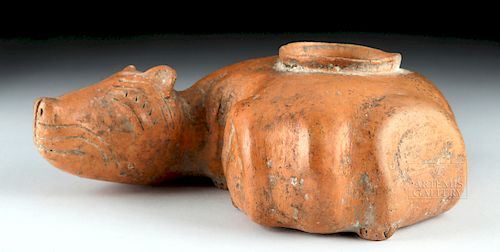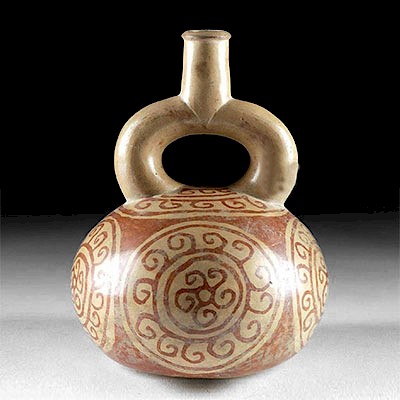Rare Teotihuacan Pottery Dog Vessel - Simply Adorable!
Lot 84g
About Seller
Artemis Gallery
686 S Taylor Ave, Ste 106
Louisville, CO 80027
United States
Selling antiquities, ancient and ethnographic art online since 1993, Artemis Gallery specializes in Classical Antiquities (Egyptian, Greek, Roman, Near Eastern), Asian, Pre-Columbian, African / Tribal / Oceanographic art. Our extensive inventory includes pottery, stone, metal, wood, glass and textil...Read more
Estimate:
$2,200 - $3,300
Absentee vs Live bid
Two ways to bid:
- Leave a max absentee bid and the platform will bid on your behalf up to your maximum bid during the live auction.
- Bid live during the auction and your bids will be submitted real-time to the auctioneer.
Bid Increments
| Price | Bid Increment |
|---|---|
| $0 | $25 |
| $300 | $50 |
| $1,000 | $100 |
| $2,000 | $250 |
| $5,000 | $500 |
| $10,000 | $1,000 |
| $20,000 | $2,500 |
| $50,000 | $5,000 |
| $100,000 | $10,000 |
| $200,000 | $20,000 |
About Auction
By Artemis Gallery
Jan 24, 2019
Set Reminder
2019-01-24 10:00:00
2019-01-24 10:00:00
America/New_York
Bidsquare
Bidsquare : Pre-Columbian / Ethnographic Art
https://www.bidsquare.com/auctions/artemis-gallery/pre-columbian-ethnographic-art-3814
Featuring ancient and ethnographic art from around the world, including Pre-Columbian, Native American, African / Tribal, Ethnographic, Spanish Colonial, Fossils, Fine Art, much more. Artemis Gallery info@artemisgallery.com
Featuring ancient and ethnographic art from around the world, including Pre-Columbian, Native American, African / Tribal, Ethnographic, Spanish Colonial, Fossils, Fine Art, much more. Artemis Gallery info@artemisgallery.com
- Lot Description
Pre-Columbian, Central Mexico, Teotihuacan, Tlamimilolpa-Metepec phases, ca. 350 to 750 CE. A sweet terracotta dog vessel, with impressively thin walls and a beautiful orange hue. Teotihuacan ceramicists and traders prized this special orange clay obtained from Puebla, Mexico and fashioned it into very thin sheets to create fabulous sculptures. This puppy presents an endearing pose, all snugly and curled up with his tail tucked in and his head and paws resting on the ground, presenting a tranquil expression comprised of incised facial features - closed eyes, lashes, brow lines, muzzle, and whiskers - as well as wrinkles here and there - that add to his personality. Size: 6.125" W x 2.75" H (15.6 cm x 7 cm)
The curatorial team of the Saint Louis Art Museum writes, "Dogs and dog-shaped vessels were often included in Teotihuacan burials, suggesting their domestication as members of the household. Their presence in central Mexico parallels a similar practice seen in some burials in West Mexico during the same period, where thin orange ceramics have also been found. Although different in form, the ceramic canines of Teotihuacan indicate a shared—if not imported—funerary practice." (http://emuseum.slam.org/objects/5612/vessel-in-the-form-of-a-sleeping-dog;jsessionid=DEFD0EDD0FAC0BFC835FD15BBC1F8B0E?ctx=c5278640-4d80-4d9e-b2cf-efbc6eab9fc7&idx=8)
Such pottery pups are among the most enduring and famous symbols of Pre-Columbian art. They come from the shaft tombs of West Mexico, where dogs were believed to assist the dead in their journey to the underworld. Although these dogs are often portrayed as fattened up for the table, they are also sculpted into a variety of playful positions, suggesting that dogs were also a close human companion in the Pre-Columbian world - just as they are today. This particular dog sleeps peacefully, in a fetal position, perhaps exhausted after a rousing afternoon of play. Anyone who loves dogs will recognize this endearing restful pose, and the piece demonstrates how important the bond between humans and dogs was even 2000 years ago! This close relationship is reflected in the cosmology of Pre-Columbian Mexican peoples, where one story tells that the first man survived a great flood because of his friend, a dog, who helped him find both corn to eat and fire.
See similar examples at The Getty (http://emuseum.slam.org/objects/5612/vessel-in-the-form-of-a-sleeping-dog;jsessionid=DEFD0EDD0FAC0BFC835FD15BBC1F8B0E?ctx=c5278640-4d80-4d9e-b2cf-efbc6eab9fc7&idx=8), National Museums in Berlin, Ethnological Museum (https://universes.art/art-destinations/mexico/tour/teotihuacan-berlin/05/), the Saint Louis Art Museum (http://emuseum.slam.org/objects/5612/vessel-in-the-form-of-a-sleeping-dog;jsessionid=DEFD0EDD0FAC0BFC835FD15BBC1F8B0E?ctx=c5278640-4d80-4d9e-b2cf-efbc6eab9fc7&idx=8),
Provenance: ex-Art for Eternity Gallery, New York, New York, USA; ex-Arte Primitivo Gallery, New York, New York, USA; ex-private Hollywood, California, USA collection, ex-Ron Normandeau/Anthropos Gallery, Laguna Beach, California, USA; ex-Howard Nowes, New York, New York, USA
All items legal to buy/sell under U.S. Statute covering cultural patrimony Code 2600, CHAPTER 14, and are guaranteed to be as described or your money back.
A Certificate of Authenticity will accompany all winning bids.
We ship worldwide and handle all shipping in-house for your convenience.
#137315Repairs to the body with restoration over the break lines, but very well done. Scattered earth and mineral deposits on the surface.Condition
- Shipping Info
-
All shipping is handled in-house for your convenience. Your invoice from Artemis Gallery will include shipping calculation instructions. If in doubt, please inquire BEFORE bidding for estimated shipping costs for individual items.
-
- Buyer's Premium



 EUR
EUR CAD
CAD AUD
AUD GBP
GBP MXN
MXN HKD
HKD CNY
CNY MYR
MYR SEK
SEK SGD
SGD CHF
CHF THB
THB
















